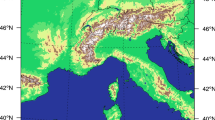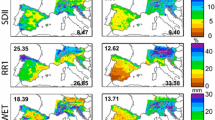Abstract
Regime-dependent evaluation is a relatively new approach to assess model performance. It consists of classifying the model biases according to a discrete number of regimes and evaluating model output within each regime. In this paper, the regimes are firstly defined by the large-scale atmospheric circulation, based on the objective Jenkinson-Collison classification technique which distinguishes synoptic patterns by strength, direction and vorticity of the geostrophic flow. Eight directional and two vorticity circulation regimes (circulation types) are specified. In this way, it is possible to quantify the model performance for cases with for example westerly winds only, or with cyclonic circulation only. A second regime classification is based on temperature, which allows for detection of temperature-dependent model performance. Modelled accumulated precipitation (mm/6 h) is evaluated with rain gauges for the years 2007 and 2008. Two variants of the COSMO model are evaluated: a fine-resolution version (2.8 km, COSMO-DE) and a coarse-resolution version (7 km, COSMO-EU). In COSMO-EU, a windward/leeward effect becomes visible since circulation is related to dominant wind direction, hence to windward and lee side of orography. In COSMO-DE, no circulation dependent but a height-related bias is identified and further explored, making use of temperature-dependent evaluation which unveils a positive model bias related to solid precipitation.











Similar content being viewed by others
References
Baldauf M, Seifert A, Förstner J, Majewski D, Raschendorfer M, Reinhardt T (2011) Operational convective-scale numerical weather prediction with the COSMO model: description and sensitivities. Mon Weather Rev. doi:10.1175/MWR-D-10-05013.1
Baldwin M, Kain J (2006) Sensitivity of several performance measures to displacement error, bias, and event frequency. Am Meteorol Soc 21(4):636–648
Baur F, Hess P, Nagel H (1944) Kalender des Großwetterlagen Europas 1881–1931. Bad Homburg vdH
Crewell S, Mech M, Reinhardt T, Selbach C, Betz HD, Brocard E, Dick G, O’Connor E, Fischer J, Hanisch T, Hauf T, Hünerbein A, Delobbe L, Mathes A, Peters G, Wernli H, Wiegner M, Wulfmeyer V (2008) The general observation period 2007 within the priority program on quantitative precipitation forecasting: Concept and first results. Meteorol Z 17:849–866
Frei C, Schöll R, Fukutome S, Schmidli J, Vidale PL (2006) Future change of precipitation extremes in Europe: Intercomparison of scenarios from regional climate models. J Geophys Res 111:D06,105. doi:10.1029/2005JD005,965
Huth R, Beck C, Philipp A, Demuzere M, Ustrnul Z, Cahynova M, Kysely J, Tveito O (2008) Classifications of atmospheric circulation patterns—recent advances and applications. Ann NY Acad Sci 1146:105–152
Illingworth A, Hogan R, O’Connor E, Bouniol D, Brooksand J, Delanoe J, Donovan D, Eastment J, Gaussiat N, Goddard J, Haeffelin M, Baltink HK, Krasnov O, Pelonand J, Piriou JM, Protat A, Russchenberg H, Seifert A, Tompkins A, Zadelhoff GJV, Vinit F, Willen U, Wilson D, Wrench C (2007) Continuous evaluation of cloud profiles in seven operational models using ground-based observations. Bull Am Meteorol Soc 88(6):883–898
Jakob C (2003) An improved strategy for the evaluation of cloud parameterizations in GCMS. Bull Am Meteorol Soc 84:1387–1401
Jakob C (2004) Cloud regimes, model evaluation and model development. GEWEX newsletter 14(4):6–8
Jakob C, Tselioudis G, Hume T (2005) The radiative, cloud, and thermodynamic properties of the major tropical western pacific cloud regimes. J Climate 18:1203–1215
Jenkinson A, Collison F (1977) An initial climatology of gales over the North Sea. Synoptic Climatology Branch Memorandum, Metetorological Office, Bracknell 62
Jones P, Hulme M, Briffa K (1993) A comparison of Lamb circulation types with an objective classification scheme. Int J Climatol 13:655–663
Lamb H (1972) British isles weather types and a register of the daily sequence of circulation patterns, 1861–1971. Geophys Mem 116:85
Mathes A, Friederichs P, Hense A (2008) Towards a quality control of precipitation data. Meteorol Z 17:733–749
Richter D (1995) Ergebnisse methodischer Untersuchungen zur Korrektur des systematischen Meßfehlers des Hellmann-Niederschlagsmessers. Ber Dtsch Wetterdienstes 194:93
Rossa A, Arpagaus M, Zala E (2003) Weather situation-dependent stratification of precipitation and upper-air verification of the Alpine Model (ALMO). COSMO Newsletter 3:123–138
Rossa A, Arpagaus M, Zala E (2004) Weather situation-dependent stratification of radar-based precipitation verification of the alpine model (almo). ERAD Publication Series 2:502–508
Rossa A, Nurmi P, Ebert E (2008) Overview of methods for the verification of quantitative precipitation forecasts. In: Michaelides S (ed) Precipitation: advances in measurement, estimation and prediction. Springer, Berlin, pp 419–452
Sevruk B, Ondras M, Chvila B (2009) The WMO precipitation measurement intercomparisons. Atmos Res 92:376–380
Steppeler J, Doms G, Schättler U, Bitzer H, Gassmann A, Damrath U, Gregoric G (2003) Meso-gamma forecasts using the nonhydrostatic model LM. Meteorol Atmos Phys 82:75–96
Tiedtke M (1989) A comprehensive mass flux scheme for cumulus parameterization in large-scale models. Mon Weather Rev 117:1779–1800
Wulfmeyer V, Behrendt A, Bauer HS, Kottmeier C, Corsmeier U, Blyth AGC, Schumann U, Hagen M, Crewell S, Girolamo PD, Flamant C, Miller M, Montani A, Mobbs S, Richard E, Rotach MW, Arpagaus M, Russchenberg H, Schlüssel P, König M, Gärtner V, Steinacker R, Dorninger M, Turner DD, Weckwerth T, Hense A, Simmer C (2008) The convective and orographically induced precipitation study: a research and development project of the world weather research program for improving quantitative precipitation forecasting in low-mountain regions. Bull Am Meteorol Soc 89:1477–1486
Acknowledgements
This paper is the result of a German-Belgian collaboration within the framework of the project Quantitative Evaluation of Regional Precipitation Forecasts Using Multi-Dimensional Remote Sensing Observations. The Belgian project is financed by the Research Foundation—Flanders and the German project by the German Research Foundation within the Priority Program on Quantitative Precipitation Forecasting on grants CR111/5 SE1784/1 AM308/1. This work would not have been possible without the dataset of the General Observation Period (GOP, http://gop.meteo.uni-koeln.de). We would like to thank all scientists who provided their data to this valuable database. The authors are especially thankful to the COST Office and the constructive discussions in the framework of COST action 733 on harmonization and applications of weather types classifications for European Regions.
Author information
Authors and Affiliations
Corresponding author
Rights and permissions
About this article
Cite this article
Akkermans, T., Böhme, T., Demuzere, M. et al. Regime-dependent evaluation of accumulated precipitation in COSMO. Theor Appl Climatol 108, 39–52 (2012). https://doi.org/10.1007/s00704-011-0502-0
Received:
Accepted:
Published:
Issue Date:
DOI: https://doi.org/10.1007/s00704-011-0502-0




